The Revenge
By Chris Marshall
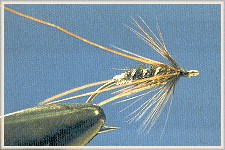
I feel a bit self-conscious writing about the Revenge as a Great
Canadian Fly, as it's my own pattern and not particularly "great."
However, it has greatness in its anchestry, for it was inspired by one of
Jack Sutton's (one of the great pioneers in Canadian fly tying) patterns
- his My Despair. As an impressionistic caddis emerger, the Despair is
hard to beat, but, with its knotted pheasant tail fibre legs, I found
it a finicky tie. Consequently, I fiddled around to see if I could
come up with a simple tie as a substitute. The end result was the
Revenge.
Like the Despair, the Revenge is meant to mimic an emerging caddis, but
it's much more impressionistic than the Despair. I kept it simple by
leaving out all the bits I found so frustratingly time-consuming - the
split, goose biot tail, the flat wing, and the knotting on the legs.
All it is, is a plump herl body with a soft hackle and pheasant tail
fibres (unknotted) to suggest legs and antennae - which all point
backward on the emerging fly. As caddis flies don't have tails, I left
this off, but added a few turns of silver tinsel as a tag, which I felt
might suggest the rear-end air bubble of the natural fly.
This all took place over 20 years ago. In that time the Revenge has come
to replace the Despair in my fly box. I'm not going to claim that it's
as good as the Despair, but it use it a lot and it produces. Moveover,
the time I save can be spent on the stream.

The Revenge can be fished with the traditional wet fly across stream cast
and downstream swing, or dead-drifted in the film with an upstream or
across stream cast to rising fish. I also tie a weighted version, which
can be fished using a sink and lift technique. The latter also works
well on still-waters, where I suspect it might be taken for a water
boatman.
Incidentally, the name "Revenge" really has nothing to do with fly tying.
I was looking for something a bit more upbeat than "Despair" to suggest
my relief from frustration at the tying bench - and, through some bizarre
connection of ganglions, I latched on to "Revenge," the name of the tiny
ship on which Sir Walter Grenville fought a magnificent delaying action
against a whole Spanish fleet over four hundred years ago. I doubt if
Sir Water was into fly fishing, but the name of his ship and its
expliots are appropriately upbeat.
|
Hook: Any curved shank, emerger hook, sizes 12-16.
Thread: Black 8/0.
Tag: Oval silver tinsel.
Body: 3-4 strands of peacock herl.
Rib: Oval silver tinsel.
Hackle: Furnace hen hackle.
Legs: Two pheasant tail fibres on each side of the body.
|
Tying Notes
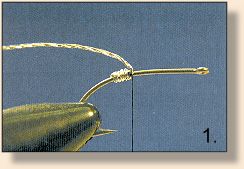
1. Anchor enough tinsel for the tag and rib on the shank just above
the hook point. Then wind 3-4 turns to make the tag. Do not remove
the excess, as this will be wound forward later as a rib.
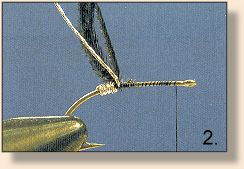
2. Just ahead of the tag, tie in 3-4 strands of peacock herl, twist
into a loose rope and wind forward towards the eye, leaving enough
space for the hackle and legs.
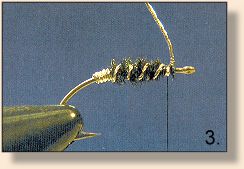
3. Wind the tinsel forward to make a ribbed body. Cut off
excess tinsel and herl and anchor.
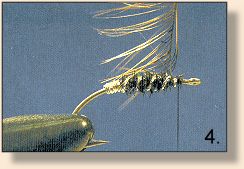
4. At the front of the body, tie in the hackle by the tip, shiny
side toward the eye. Using a dab of saliva, fold the hackle fibres back
against each other.
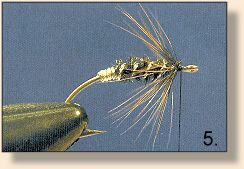
5. Wind just three turns (no more) to make a collar. Avoid flattening
the fibres back against the body with the thread as you anchor the feather.
The hackle should stand out from the body to create that important
pulsating effect on the swing or retrieve.
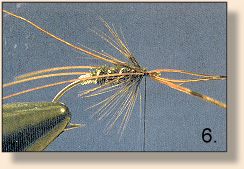
6. Tie in Two pheasant tail feathers on one side just ahead of
the hackle. They should extend just half the length of the hook
shank beyond the bend. You'll find that the hackle will push them
out from the body at 30 to 40 degrees from the shank. This is OK.
They'll flatten against the body on the swing or retrieve, yet have
enough spring to give the fly life.
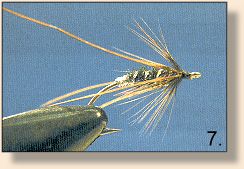
7. Finish with a tapered head, a whip finish, and a dab of cement.
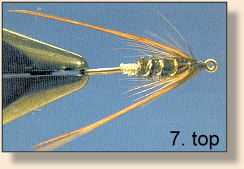
~ Chris Marshall
|










